
| Genus List |
10a. Size large (HW greater than 2.9mm): 20
10b. Size small (HW less than 2.4mm): 200
20a. Gaster covered with abundant long suberect setae: 30
20b. Gaster covered with short pubescence or abundant shorter appressed setae: 40

30a. Setae on gaster stiffer, orange brown; a median longitudinal channel on gastral dorsum devoid of setae, continuous from first to sixth gastral tergum: Nomamyrmex esenbeckii
30b. Setae on gaster more flexuous, yellower; median longitudinal bare channel attenuates posteriorly, such that sixth abdominal tergum has even covering of setae: Nomamyrmex hartigii

40a. Anterior margin of clypeus convex, although median portion may be flat or emarginate; mesoscutum with abundant long setae: 50
40b. Anterior margin of clypeus not at all projecting, entirely flat or forming a broad concave arch; mesoscutum with or without long setae: 70
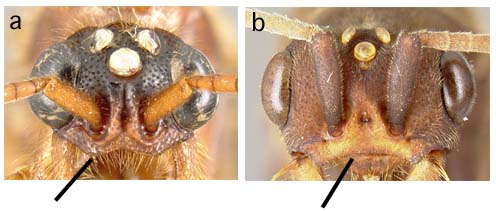
50a. Anterior margin of clypeus evenly and strongly convex; color dark brown: Labidus spininodis/curvipes
50b. Anterior margin of clypeus flat or emarginate; color orange brown: 60
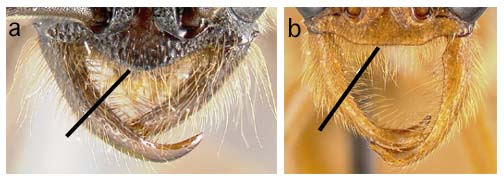
60a. Anterior margin of clypeus emarginate; mandibles evenly tapering to acute tip; ventral surface of subgenital plate with medial and lateral patches of setae separated by midlateral bare areas: Labidus coecus
60b. Anterior margin of clypeus flat; mandibles not evenly tapered at tip, remaining broad, obliquely truncate at apex: Labidus praedator
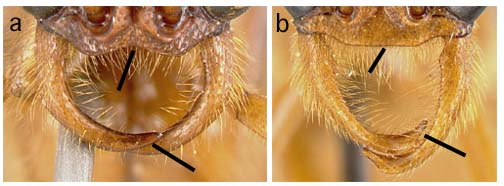
70a. Greatest width of mandible distinctly greater than distance between antennal bases: Eciton mexicanum
70b. Greatest width of mandible about equal to or less than distance between antennal bases: 80
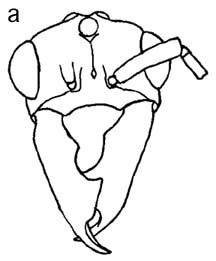
80a. Apex of mandible broadly rounded: Eciton lucanoides
80b. Apex of mandible pointed or angular: 90

90a. Mandible relatively thinner and more tapering: 100
90b. Mandible relatively broader: 110

100a. Outer surface of mandible almost straight along its basal 2/3: Eciton burchellii foreli, Eciton burchellii parvispinum
100b. Outer surface of mandible distinctly bent or convex along its basal one third to one half: Eciton dulcium crassinode

110a. Gaster without long setae: Eciton vagans angustatum
110b. Gaster with long setae: Eciton hamatum
200a. Clypeus with two broadly triangular projecting teeth: 210
200b. Clypeus lacking projecting teeth: 220
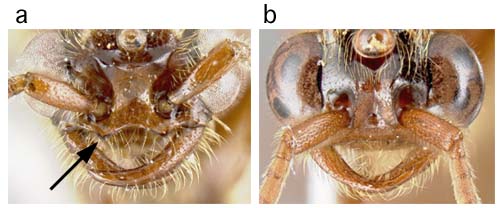
210a. Face with large, lozenge-shaped projection near lateral ocellus, adjacent to inner margin of compound eye; face in front of median ocellus with two prominent carinae that descend to near clypeal teeth, forming V-shaped medial trough between them, carinae continue posteriorly to near median ocellus, not forming shelf or pocket anterior to ocellus: Neivamyrmex radoszkowskyi
210b. Face lacking lozenge-shaped projection; face in front of median ocellus with less conspicuous, widely-separated carinae, the space between them broad and shallowly concave, space immediately anterior to median ocellus with two blunt, broadly triangular projections, forming a projecting shelf or pocket in front of the ocellus: Neivamyrmex klugi distans
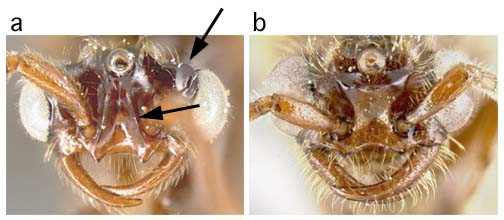
220a. Anterior coxa greatly enlarged, forming angular, scoop-like plate; mandible with a distinct bend about one third distance from base; color dark red brown: Neivamyrmex RVC-003
220b. Anterior coxa not forming large scoop-like plate; mandible various; color various: 230
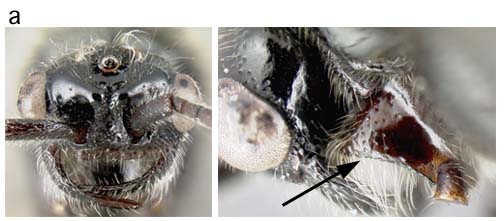
230a. In full face view, posterior margin of head forming a broad even arch or not visible behind ocelli, posterolateral margin of compound eye and lateral vertex meet at the same angle, forming a more or less continuous margin that is strongly oblique or horizontal; in lateral view compound eye often covers entire side of head: 240
230b. Posterior margin of head with more defined lateral and posterior margins that meet at a rounded shoulder, posterolateral margin of compound eye meets side of head at more of an angle; in lateral view compound eye smaller, situated anteriorly, such that more of posterolateral vertex visible: 300
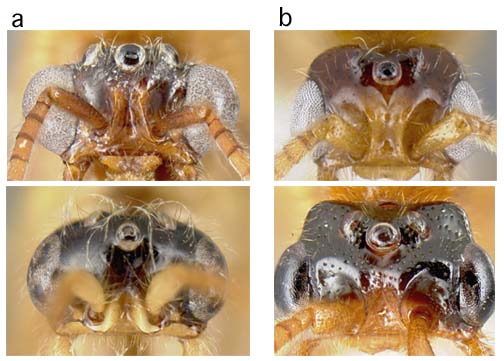
240a. Mandible more or less evenly curved and evenly tapering to acute tip: 250
240b. Mandible robust, bent at base, apical two thirds more or less straight and broad, not evenly tapering (see also 240c): 280
240c. Mandible relatively delicate, nearly straight to near apex, where it curves and tapers to acute tip, inner margin medially convex: 245
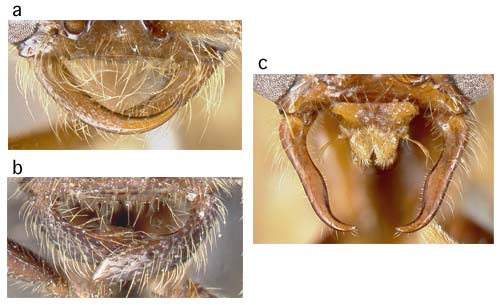
245a. Mesosoma and metasoma light brown; setae around ocelli shorter than width of median ocellus; frontal carinae attenuated posteriorly, not angulate: Neivamyrmex pilosus mexicanus
245b. Mesosoma and metasoma dark red brown; setae around ocelli longer than width of median ocellus; frontal carinae dentate posteriorly, forming nearly right angles: Neivamyrmex longiscapus [= impudens (Mann 1922)]
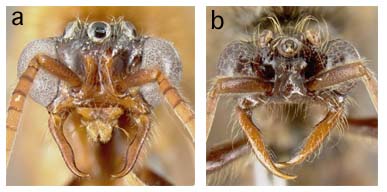
250a. Apex of subgenital plate with 4 teeth: Neivamyrmex halidaii
250b. Apex of subgenital plate with 3 teeth: 260
260a. Head nearly black, contrasting with lighter brown mesosoma and metasoma; frontal carinae strongly developed anteriorly as flanges that extend beyond anterior border of clypeus, attenuating rapidly posteriorly, not extending much beyond antennal insertions; scutellum bulbous, extending over propodeum; HW about 1.6mm: Neivamyrmex RVC-009
260b. Color more uniform red brown; frontal carinae less developed anteriorly, extending up to but not beyond anterior margin of clypeus, extending further posteriorly; scutellum small, not extending over propodeum; HW various: 270

270a. Frontal carinae attenuating posteriorly near median ocellus, not extending to lateral ocelli; HW greater than 2.2mm: Neivamyrmex swainsonii
270b. Frontal carinae more developed posteriorly, curving laterally and extending to bases of lateral ocelli; HW less than 1.5mm: Neivamyrmex fumosus
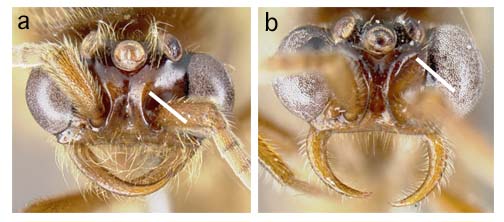
280a. Mandible and face with abundant coarse foveae; ocelli clustered medially, such that distance between medial and lateral ocellus much less than distance from lateral ocellus to compound eye; color nearly black: Neivamyrmex spatulatus
280b. Mandible and face lacking coarse foveae; ocelli larger and less clustered medially, distance between medial and lateral ocellus about equal to distance from lateral ocellus to compound eye; color red brown: Neivamyrmex rosenbergi
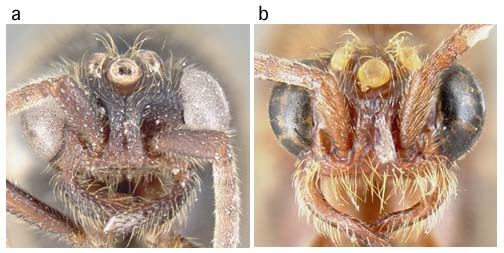
300a. Mandible evenly tapered from base to apex: 320
300b. Mandible not evenly tapered, inner margin forming two concave surfaces separated by a shallow angle at about one fourth distance from base to apex (see also 300c): Neivamyrmex JTL-002
300c. Mandible not evenly tapered, inner margin forming two concave surfaces separated by a shallow angle at about two thirds distance from base to apex: Neivamyrmex JTL-004

320a. HW about 1.5mm; aedeagus with dorsal lobe much longer than ventral lobe; volsella forked; posterolateral vertex and mesoscutum with uniformly distributed large puncta; face dark brown, strongly contrasting with orange brown mesosoma: Neivamyrmex spoliator
320b. HW about 0.9-1.0mm; aedeagus with dorsal lobe about same length as ventral lobe; volsella not forked; sculpture on posterolateral vertex variable; color variable: 330

330a. Posterolateral vertex and area between median and lateral ocellus with uniform field of large puncta; anterior mesoscutum with uniform large puncta; dorsal lobe of paramere ends beyond midlength, ventral lobe evenly tapering to acute tip, not curved upward: Neivamyrmex digitistipus
330b. Posterolateral vertex largely smooth and shining or with less conspicuous puncta; anterior mesoscutum usually with smaller puncta (Osa Peninsula specimens with larger puncta); dorsal lobe of paramere ends before midlength, ventral lobe long, sublinear before tapering apex, curving upward: Neivamyrmex digitistipus_nr
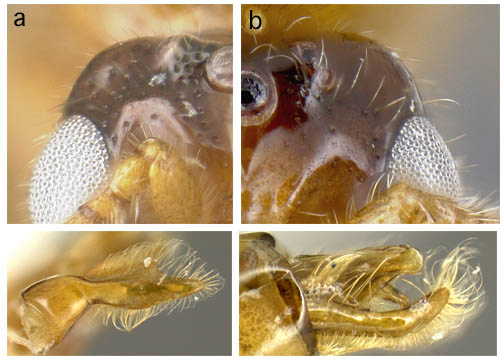
Page author:
John T. Longino, The Evergreen State College, Olympia WA 98505 USA.longinoj@evergreen.edu